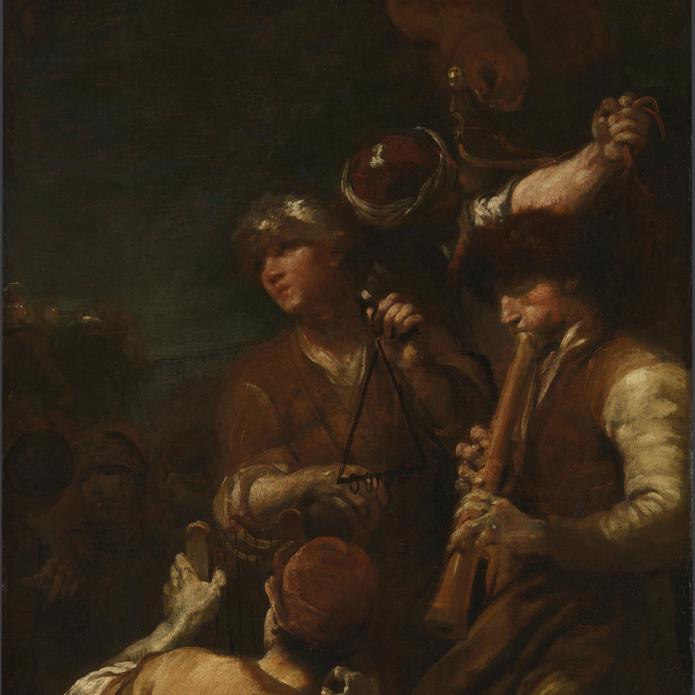Giuseppe Maria Crespi, 'Peasants with Donkeys', about 1710-15
About the work
Overview
Crespi is best known today for his paintings of everyday life. This scene, in which a man lifts a heavy basket of bread rolls from the side of his donkey, draws on the Bolognese tradition of depicting street vendors at their work. A bearded figure on the right raises his hand to purchase three of them, while the woman next to him looks intently towards the seller in an attempt to get his attention. A man carrying a sack on his shoulders strides past, glancing at the central figure as if he’s reacting to something the man is saying.
The nocturnal setting allows for a dramatic contrast between light and dark areas, with particular details highlighted, such as the vendor’s muscular forearm and white sleeve. The three figures to the lower right emerge out of the gloom, the light revealing their individual facial features and expressions.
Key facts
Details
- Full title
- Peasants with Donkeys
- Artist
- Giuseppe Maria Crespi
- Artist dates
- 1665 - 1747
- Part of the series
- Two Peasant Scenes
- Date made
- about 1710-15
- Medium and support
- oil on canvas
- Dimensions
- 94.1 × 53.8 cm
- Acquisition credit
- Presented by the Trustees of Sir Denis Mahon's Charitable Trust through the Art Fund, 2013
- Inventory number
- NG6627
- Location
- Not on display
- Collection
- Main Collection
- Frame
- 20th-century Replica Frame
Provenance
Additional information
Text extracted from the ‘Provenance’ section of the catalogue entry in Gabriele Finaldi and Michael Kitson, ‘Discovering the Italian Baroque: The Denis Mahon Collection’ (exh. cat. National Gallery, London, 1997), London 1997 and supplemented by the National Gallery’s Annual Report, ‘The National Gallery: Review of the Year, April 2012 – March 2013’; for further information, see the full catalogue entry.
Bibliography
-
2001
C. Baker and T. Henry, The National Gallery: Complete Illustrated Catalogue, London 2001
-
2014National Gallery, The National Gallery: Review of the Year, April 2012 - March 2013, London 2014
About this record
If you know more about this work or have spotted an error, please contact us. Please note that exhibition histories are listed from 2009 onwards. Bibliographies may not be complete; more comprehensive information is available in the National Gallery Library.
Images
About the series: Two Peasant Scenes

Overview
Peasants with Donkeys and its companion painting Musicians are intimate scenes of peasant life, observed by night as if we ourselves are part of the action. Both make use of a warm, earthy palette and lively, loose brushwork to bring the figures they depict to life. The two pictures probably date from between 1710 and 1715, shortly after Crespi’s stay in Florence.
These pictures were formerly thought to be fragments of a single composition, perhaps an Old Testament subject. Close examination of the canvases, however, has shown that they were part of two separate, though related, works. Both have at some point been cut down at the left and top edges, and it is impossible to know how large they originally were. They are slightly different sizes but the similarities in the scale of the figures, the range of colour and the lively brushstrokes suggest that they must have been intended to hang together.



